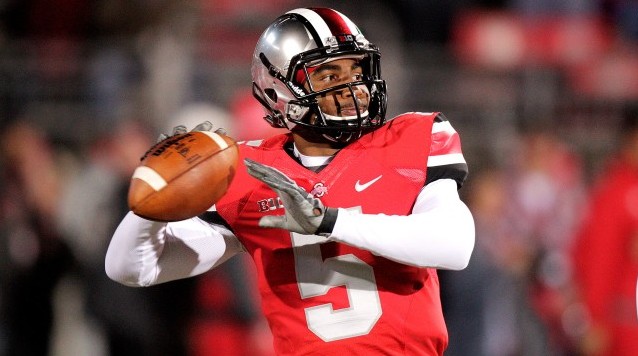You know the saying; “If you have two quarterbacks, you actually have none.” That trend was supposed to be bucked with Ohio State this season, and there was good reason to believe so. Except in Ohio State’s case, rather than two, the Buckeyes had a trio of signal-callers, all with proven track records.
Back was Cardale Jones, a tall drink of water with a cannon of an arm who had just engineered an improbable run through the first ever College Football Playoff. Supposedly playing nice in the sandbox was also returning two-time offensive player of the year Braxton Miller, equipped with a brand new surgically repaired shoulder. Last, but certainly not the least of an afterthought, was J.T. Barrett. All he did was set school and Big Ten records in 2014 prior to giving way to Jones because of a broken ankle suffered against Michigan in the season finale.
Talk about your embarrassment of riches.
Yet, maybe this whole quarterback Russian Roulette wasn’t a blessing after all. Maybe it was just enough of a tinkering distraction to divide and pull the team into too many directions without a true North to guide the offense. Miller was taken out of the mix early with a move to wide receiver, but what was left was a tug-of-war involving Jones, Barrett, and the coaching staff that left a bad taste in everyone’s mouth.
Early on, in a bit of a surprising move, Jones was given the green light. There were some early flashes of the 2014 magic, but by and large, without the departed deep threat (Devin Smith) to show off that arm, he wasn’t the same quarterback. He was tentative in the pocket, inaccurate with his passes, and slow to make his way through progressions.
Barrett wasn’t much better through the first half of the season. When given the opportunity when the lights were on, he too looked like a shell of himself, likely shaking off the rust from the ankle injury that had kept him out of live game action for nine months. What resulted was a see-saw affair of each spelling the other when the offense was stagnant and mired in the expectations of what should be.
Through it all, Jones remained the de facto starter.
The tinkering and experimenting finally led to Barrett being named the red zone quarterback, but not the starter, a designation which still belonged to Jones. Instead, No. 16 was showcased as a change of pace and a running threat inside the opponent’s 20-yard line. The move succeeded, and because of the success, Barrett was finally, mercifully, given the keys to the offense for the October 31 game at Rutgers.
Too little too late?
It’s not often that you can second-guess a coach the caliber of Urban Meyer, but by letting the quarterback quandary go on so long, the team never really had a chance to cement its identity early on in the season. The skill sets of both are somewhat similar, but there are more pass blocking schemes with Jones in the game, and more run and read-blocking designs with Barrett dialing up plays. Instead of being on the same schedule of improvement with teams that had a solidified quarterback, the Ohio State offense was left to try to improve with its known personnel over the last three weeks.
Add the OVI charge and one-week suspension Barrett had to absorb, and in all actuality, there really were only two weeks of learning on the job before the really big games began show up on the schedule. We all know what happened from there.
It’s clear now that Ohio State is what it is. It’s time for everyone waiting for this offense to click to wake up to the reality of it all. The Buckeyes miss the deep passing threat they had last year with Smith, the aforementioned track star. OSU misses the downfield blocking and route running that wide receiver Evan Spencer provided. Amazingly and shockingly, it misses the chemistry of last year’s offensive line despite losing just Billy Price (and no one else) from a year ago. It clearly and sorely misses a talented offensive coordinator in Tom Herman, who is now doing some pretty good things as a head coach at Houston.
Most importantly, maybe — just maybe — the thing Ohio State missed most in 2015 was a clearly defined leader under center that everyone could get behind and follow through the fires towards another run through the Big Ten and beyond.
Unfortunately we’ll never know, because the team can’t get that time back. This year, instead of improving and peaking at the right time, Ohio State is left to try to salvage what’s now left — a date with a Jim Harbaugh-led Michigan team that named Jake Rudock the starter in game one with even more unknowns surrounding the season.
Urban Meyer may never admit it, but this is a season in which a lot of hard lessons can be learned. The first and most important is, “If you have two quarterbacks, you actually have none.” Now maybe we all know what that means.
*
Phil Harrison is a contributor to The Student Section. He is also a the founder of Big10news.com and featured contributor to collegefootballews.com, talking10.com, and occasionally campusinsiders.com. You can follow him on twitter @PhilHarrisonCFB or email him at pharrison28@gmail.com. If that doesn’t work, you can find him in the doghouse at home.

